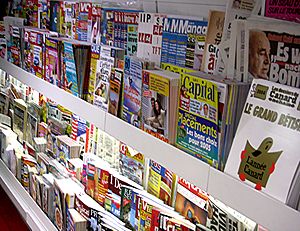Page layout facts for kids
Page layout is all about how you arrange text, pictures, and other things on a page. It's a key part of graphic design and making things look good, whether it's a printed book or a screen on your computer or phone.
Contents
How Page Layout Started and Grew
Designing pages has been important for a very long time. It began with illuminated manuscripts, which were beautiful, hand-copied books made in the Middle Ages. These old books had carefully placed drawings and fancy letters.
Today, page layout is used for everything from magazines and catalogs to websites. It involves arranging text, images, and sometimes special design elements like foil stamping (adding shiny foil) or embossing (making parts of the paper stick out).
Page Layout in the Digital Age
With the rise of computers, page layout skills are now used for digital screens too. The "electronic page" – like what you see on a computer screen – is where a lot of design happens now.
Designers might start by sketching ideas on paper. Then, they use special software to create the final layout. For web pages, designers also need to know about markup languages (like HTML) and WYSIWYG software. WYSIWYG means "What You See Is What You Get," so you can see how your page will look as you design it.
It's important for web pages to look good no matter the screen size. CSS helps keep the page layout consistent across different web browsers.
Grids and Templates: Design Helpers
Grids and templates are like secret tools designers use. They help make sure pages look organized and consistent, especially for things like advertising campaigns or websites with many pages.
What is a Grid?
A grid is a set of invisible lines or guides. Designers can see these lines, but you, the person looking at the page, can't. Grids help designers line up elements like text boxes and pictures. They make sure things are spaced evenly and look neat. Grids are flexible, meaning designers can choose to follow them closely or break away for a unique look.
What is a Template?
A template is more like a ready-made design. It has repeated elements that you *can* see, like a specific header or footer. Templates are great for things that need to look the same on many pages, like a company's newsletter or a blog. Using a template often requires less design skill because many parts are already set up. You mostly just add your own content.
Most design software lets you use grids. They show up as colored lines or dots on your screen. Software also uses "master pages" for templates. Master pages can include grid elements, page numbers, and other repeating parts for a whole document.
Images for kids
-
Editors working on a newspaper in West Berlin, 1977.
See also
 In Spanish: Maquetación para niños
In Spanish: Maquetación para niños



